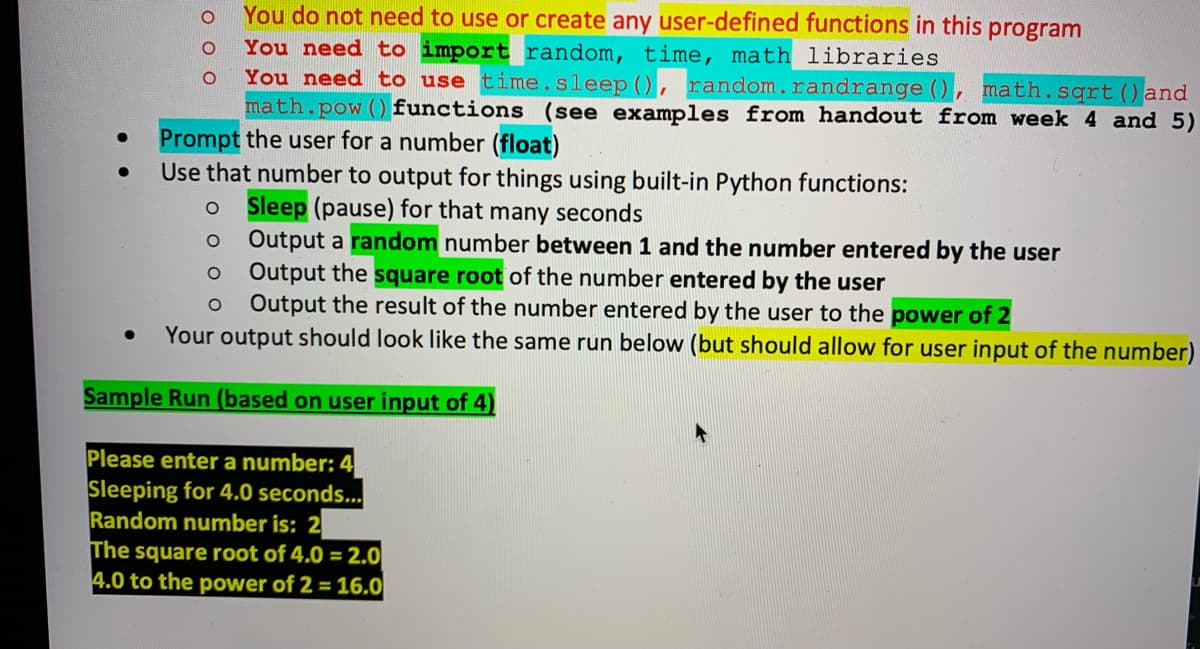in this program You need to import random, time, math libraries You need to use time.sleep (), random.randrange (), math.sqrt () an math.pow () functions (see examples from handout from week 4 and Prompt the user for a number (float) Use that number to output for things using built-in Python functions: Sleep (pause) for that many seconds Output a random number between 1 and the number entered by the user o Output the square root of the number entered by the user o Output the result of the number entered by the user to the power of 2 Your output should look like the same run below (but should allow for user input of the numbe Sample Run (based on user input of 4) Please enter a number: 4 Sleeping for 4.0 seconds... Random number is: 2 The square root of 4.0 = 2.0 4.0 to the power of 2 = 16.0 оо
in this program You need to import random, time, math libraries You need to use time.sleep (), random.randrange (), math.sqrt () an math.pow () functions (see examples from handout from week 4 and Prompt the user for a number (float) Use that number to output for things using built-in Python functions: Sleep (pause) for that many seconds Output a random number between 1 and the number entered by the user o Output the square root of the number entered by the user o Output the result of the number entered by the user to the power of 2 Your output should look like the same run below (but should allow for user input of the numbe Sample Run (based on user input of 4) Please enter a number: 4 Sleeping for 4.0 seconds... Random number is: 2 The square root of 4.0 = 2.0 4.0 to the power of 2 = 16.0 оо
Database System Concepts
7th Edition
ISBN:9780078022159
Author:Abraham Silberschatz Professor, Henry F. Korth, S. Sudarshan
Publisher:Abraham Silberschatz Professor, Henry F. Korth, S. Sudarshan
Chapter1: Introduction
Section: Chapter Questions
Problem 1PE
Related questions
Question
100%

Transcribed Image Text:You do not need to use or create any user-defined functions in this
You need to import random, time, math libraries
You need to use time.sleep (), random.randrange (), math.sqrt () and
math.pow () functions (see examples from handout from week 4 and 5)
program
Prompt the user for a number (float)
Use that number to output for things using built-in Python functions:
Sleep (pause) for that many seconds
Output a random number between 1 and the number entered by the user
Output the square root of the number entered by the user
Output the result of the number entered by the user to the power of 2
Your output should look like the same run below (but should allow for user input of the number)
Sample Run (based on user input of 4)
Please enter a number:
Sleeping for 4.0 seconds...
Random number is: 2
The square root of 4.0 = 2.0
4.0 to the power of 2 = 16.0
ооо
Expert Solution
This question has been solved!
Explore an expertly crafted, step-by-step solution for a thorough understanding of key concepts.
This is a popular solution!
Trending now
This is a popular solution!
Step by step
Solved in 3 steps with 1 images

Knowledge Booster
Learn more about
Need a deep-dive on the concept behind this application? Look no further. Learn more about this topic, computer-science and related others by exploring similar questions and additional content below.Recommended textbooks for you

Database System Concepts
Computer Science
ISBN:
9780078022159
Author:
Abraham Silberschatz Professor, Henry F. Korth, S. Sudarshan
Publisher:
McGraw-Hill Education

Starting Out with Python (4th Edition)
Computer Science
ISBN:
9780134444321
Author:
Tony Gaddis
Publisher:
PEARSON

Digital Fundamentals (11th Edition)
Computer Science
ISBN:
9780132737968
Author:
Thomas L. Floyd
Publisher:
PEARSON

Database System Concepts
Computer Science
ISBN:
9780078022159
Author:
Abraham Silberschatz Professor, Henry F. Korth, S. Sudarshan
Publisher:
McGraw-Hill Education

Starting Out with Python (4th Edition)
Computer Science
ISBN:
9780134444321
Author:
Tony Gaddis
Publisher:
PEARSON

Digital Fundamentals (11th Edition)
Computer Science
ISBN:
9780132737968
Author:
Thomas L. Floyd
Publisher:
PEARSON

C How to Program (8th Edition)
Computer Science
ISBN:
9780133976892
Author:
Paul J. Deitel, Harvey Deitel
Publisher:
PEARSON

Database Systems: Design, Implementation, & Manag…
Computer Science
ISBN:
9781337627900
Author:
Carlos Coronel, Steven Morris
Publisher:
Cengage Learning

Programmable Logic Controllers
Computer Science
ISBN:
9780073373843
Author:
Frank D. Petruzella
Publisher:
McGraw-Hill Education